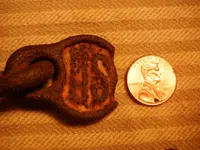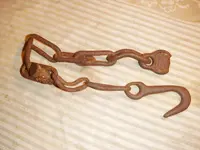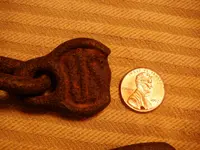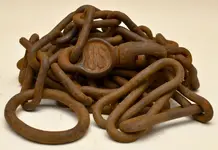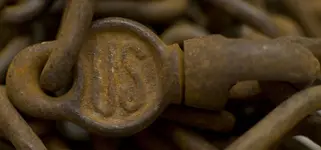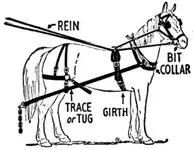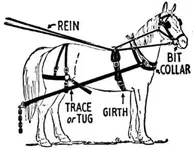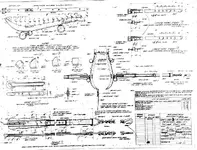You are using an out of date browser. It may not display this or other websites correctly.
You should upgrade or use an alternative browser.
You should upgrade or use an alternative browser.
Help - WWI Horse tack??
- Thread starter parsonwalker
- Start date
BosnMate
Gold Member
- Joined
- Sep 10, 2010
- Messages
- 6,916
- Reaction score
- 8,441
- Golden Thread
- 0
- Detector(s) used
- Whites MXT, Whites DFX, Whites 6000 Di Pro
- Primary Interest:
- Other
Yeah, at least. The reason I know is because in the 60's we had army surplus work harness that had those trace chains. The last of the army horse stuff was the beginning of WWII. I have no idea how much older those style of trace chains date to, but for sure WWI.
Upvote
0
TheCannonballGuy
Gold Member
- Joined
- Feb 24, 2006
- Messages
- 6,607
- Reaction score
- 13,455
- Golden Thread
- 0
- Location
- Occupied CSA (Richmond VA)
- Detector(s) used
- White's 6000, Nautilus DMC-1, Minelab
- Primary Interest:
- Relic Hunting
Rather than a "rebuttal," please think of this as a contribution of helpful information.
About a year ago, while I was researching the time-period of these US-marked SO-CALLED "artillery trace-chains." I came across the following educational diagram. It is an official US Army Commisary Department document, and is marked as such at the lower right in the diagram. It is titled "Harness, Ambulance Or Escort Wagon, Lead And Wheel, Double Sets -- Trace, Hame: Straps, Hame." Unfortunately, it is a low-resolution scan of the original document... which makes some of the writing difficult to read, and in particular, the date, which seems to be Nov. 5, 19--. But because the US Army quit using horse-drawn wagons by sometime in the 1930s, we can be sure the diagram's date of 19-- is sometime between 1900 and 1939... and most likely in the earlier part of that range.
I hope somebody in this forum is good at digital image enhancement, and can clear up this low-rez scan's writing for us.
In the meantime, I'll do the best I can at interpreting important parts of the writing. Note that at the diagram's bottom left, we see a drawing marked "TRACE [something]" and below it, "body, [something,] trace-guard and [something:] black harness leather, medium, 12/64 thick [plus or minus 1/64.)"
Also, note that Creskol's mention of concern about "flesh-wounds" is correct, most of the trace's length is leather, in order to protect the horse from flesh-wounds which a chain would inflict. The chain part of the trace is only at its end BEYOND the horse's body... as shown in the drawing posted by BosnMate. (I should mention that the diagram has a black space (representing a gap) in the strap and in the chain, because they are too lengthy to draw their full length in the diagram.)
Lastly, note that the trace end's chain and HOOK is the same shape as the one found by Parsonwalker... except that the swivel on the diagram's chain is unmarked.
I should mention that in addition to BosnMate's testimony in this discussion that these "US" chains are from the early-1900s, I've talked with elderly farmers who've told me the same thing BosnMate said. These US wagon-horseharness traces were sold as Army-Surplus equipment after World War 2 through the 1960s. They date from no earlier than the first decades of the 20th-Century. For example, a close personal friend of mine lives on a horse-boarding farm, and he found TEN sets of these US-marked chains in the old barn... so how likely is it that they are from the civil war?
In closing, I've got two questions for Creskol:
1- As the drawing posted by BosnMate shows, the wagonhorse harness-with-traces seems to be for use by a single horse. Was it also used for two horses side-by-side?
2- Was the harness-with-traces ever used for a team of more than two horses? If not, that would exclude it from being Artillery horseharness, because you needed no fewer than four horses to pull the enormous weight of a cannon or a caisson (artillery ammo-wagon).
One other request (already mentioned above)... I hope somebody in this forum is good at digital image enhancement, and can clear up this low-rez scan's writing for us.
About a year ago, while I was researching the time-period of these US-marked SO-CALLED "artillery trace-chains." I came across the following educational diagram. It is an official US Army Commisary Department document, and is marked as such at the lower right in the diagram. It is titled "Harness, Ambulance Or Escort Wagon, Lead And Wheel, Double Sets -- Trace, Hame: Straps, Hame." Unfortunately, it is a low-resolution scan of the original document... which makes some of the writing difficult to read, and in particular, the date, which seems to be Nov. 5, 19--. But because the US Army quit using horse-drawn wagons by sometime in the 1930s, we can be sure the diagram's date of 19-- is sometime between 1900 and 1939... and most likely in the earlier part of that range.
I hope somebody in this forum is good at digital image enhancement, and can clear up this low-rez scan's writing for us.
In the meantime, I'll do the best I can at interpreting important parts of the writing. Note that at the diagram's bottom left, we see a drawing marked "TRACE [something]" and below it, "body, [something,] trace-guard and [something:] black harness leather, medium, 12/64 thick [plus or minus 1/64.)"
Also, note that Creskol's mention of concern about "flesh-wounds" is correct, most of the trace's length is leather, in order to protect the horse from flesh-wounds which a chain would inflict. The chain part of the trace is only at its end BEYOND the horse's body... as shown in the drawing posted by BosnMate. (I should mention that the diagram has a black space (representing a gap) in the strap and in the chain, because they are too lengthy to draw their full length in the diagram.)
Lastly, note that the trace end's chain and HOOK is the same shape as the one found by Parsonwalker... except that the swivel on the diagram's chain is unmarked.
I should mention that in addition to BosnMate's testimony in this discussion that these "US" chains are from the early-1900s, I've talked with elderly farmers who've told me the same thing BosnMate said. These US wagon-horseharness traces were sold as Army-Surplus equipment after World War 2 through the 1960s. They date from no earlier than the first decades of the 20th-Century. For example, a close personal friend of mine lives on a horse-boarding farm, and he found TEN sets of these US-marked chains in the old barn... so how likely is it that they are from the civil war?
In closing, I've got two questions for Creskol:
1- As the drawing posted by BosnMate shows, the wagonhorse harness-with-traces seems to be for use by a single horse. Was it also used for two horses side-by-side?
2- Was the harness-with-traces ever used for a team of more than two horses? If not, that would exclude it from being Artillery horseharness, because you needed no fewer than four horses to pull the enormous weight of a cannon or a caisson (artillery ammo-wagon).
One other request (already mentioned above)... I hope somebody in this forum is good at digital image enhancement, and can clear up this low-rez scan's writing for us.
Attachments
Last edited:
Upvote
0
BosnMate
Gold Member
- Joined
- Sep 10, 2010
- Messages
- 6,916
- Reaction score
- 8,441
- Golden Thread
- 0
- Detector(s) used
- Whites MXT, Whites DFX, Whites 6000 Di Pro
- Primary Interest:
- Other
I don't know where you are from, but where I'm from we don't have "heel chain," we call it "trace chain." Have called them that all my life, and all the old fardts I've been around called them that. It's chain and attached to the end of the traces. We called work harness "traces" and driving harness tugs. Our driving harness didn't have chain, it was leather tugs to the whiffle tree, (single horse in shafts) I've never driven a team on a buggy, but I assume it's the same, leather tugs to the double tree. I didn't buy our work harness, I was a kid, and assumed it was army surplus because of the US swivel on the "trace" chains, and I'm certainly not an expert, but I'm old enough that there were still a few people farming with horses. You are the first person to suggest that it's not army harness. You say the army wouldn't use them, because they injure horses. I'm assuming that you are talking about chain all the way from the collar, I'm not, and have never seen that. I've never seen a horse injured by what I call trace chain, but then I've never seen a horse throw a fit in harness either. I guess a bronco horse might go nuts, and I suppose a runaway could get hurt by all sorts of things in the following wreck. I don't ever recall seeing a leather covered trace chain, either one you are talking about, or my style of trace chain, but again, I've not done a study on the subject, all I know is from limited personal experience a long time ago. I've yarded logs (not with army harness) and pulled a stoneboat (with army harness) when I was in my 20's, no leather covered what I call trace chains and nothing got hurt. One was a gentle team of mules, the other a gentle horse, and neither ran off or threw a fit. Terminology can be a local thing. I've never tightened a girth on a horse, but I've cinched up a lot of them. I never had a girth on my saddle, I had a cinch. On the off side I used a Mormon billet, on the near side a latigo. So I will still use my local terminology and use the term "trace chain," for what you call "heel chain," and I'll call it army harness until someone can prove that it was something else. Perhaps Forest Service, or maybe CCC road crews, I don't know. I do know it was on the harness I used, and it was connected to the traces, and it wasn't leather covered. I've never had a team and wagon, but a I've been around them, and the ones I've eyeballed once again, had trace chains, you call heel chains, which attach to the double trees and they aren't leather covered, they are attached at the end of the traces as opposed to being traces.
Upvote
0
BosnMate
Gold Member
- Joined
- Sep 10, 2010
- Messages
- 6,916
- Reaction score
- 8,441
- Golden Thread
- 0
- Detector(s) used
- Whites MXT, Whites DFX, Whites 6000 Di Pro
- Primary Interest:
- Other
All I can make out on the diagram is the army called them "Traces," not tugs. The chain isn't named, and the swivel on the chain is in a totally
different place. On my harness the chain had a ring rather than a hook, and the swivel was 10 links from the ring. There was probably twice
that many links to the "D" ring attachment at the leather trace.
different place. On my harness the chain had a ring rather than a hook, and the swivel was 10 links from the ring. There was probably twice
that many links to the "D" ring attachment at the leather trace.
Upvote
0
BosnMate
Gold Member
- Joined
- Sep 10, 2010
- Messages
- 6,916
- Reaction score
- 8,441
- Golden Thread
- 0
- Detector(s) used
- Whites MXT, Whites DFX, Whites 6000 Di Pro
- Primary Interest:
- Other
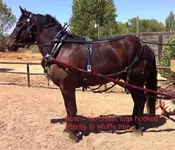
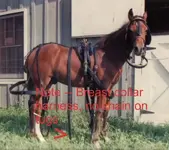
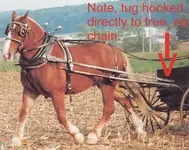
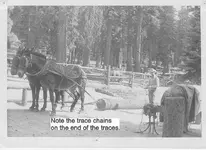
So what's this prove? Nothing, just that different areas have different names for the same thing.
Note photo number 3. Length of adjustment of the tugs is taken care of by a number of button type
holes in the leather tugs. I suspect that if, where your from, if you look around a bit you
will find adjustable tugs without chain.
Last edited:
Upvote
0
creskol
Gold Member
In closing, I've got two questions for Creskol:
1- As the drawing posted by BosnMate shows, the wagonhorse harness-with-traces seems to be for use by a single horse. Was it also used for two horses side-by-side?
2- Was the harness-with-traces ever used for a team of more than two horses? If not, that would exclude it from being Artillery horseharness, because you needed no fewer than four horses to pull the enormous weight of a cannon or a caisson (artillery ammo-wagon).
I am sure that BosnMate is much more qualified than I to address your questions .. just ask him.
Upvote
0
BosnMate
Gold Member
- Joined
- Sep 10, 2010
- Messages
- 6,916
- Reaction score
- 8,441
- Golden Thread
- 0
- Detector(s) used
- Whites MXT, Whites DFX, Whites 6000 Di Pro
- Primary Interest:
- Other
In answer to Cannonballguys question: "In closing, I've got two questions for Creskol:
1- As the drawing posted by BosnMate shows, the wagonhorse harness-with-traces seems to be for use by a single horse. Was it also used for two horses side-by-side?
2- Was the harness-with-traces ever used for a team of more than two horses? If not, that would exclude it from being Artillery horseharness, because you needed no fewer than four horses to pull the enormous weight of a cannon or a caisson (artillery ammo-wagon)."
Yes, each animal in the team has exactly the same harness with the same traces. The wheel animals, "wheelers," have
a tongue between them. If the gun is being pulled by a "four up" the front animals are the leaders, however if they are
using 6 horses or mules, the front team is the leaders, and the middle animals are called the "swing" team, then the
wheelers with the tongue between them. The 4 up leaders have a chain that attaches to the tongue on the caisson at one end and
the lead teams double tree on the other. I found a pretty good picture that will explain better than me trying to type all this
information.
View attachment 859257
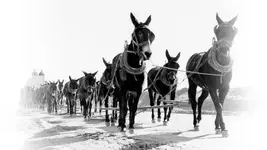
This is a 20 mule team, note each animal has the same harness. In this photo, the traces have much
longer chains, I think this must be what Cresol was talking about. There is short leather trace coming from the collar, then
a long chain. Anyhow, the picture shows the leaders and shows how the traces are attached to a double tree. From that
double tree, there is a chain running all the way to the wagon tongue, and each team except the wheelers are attached to,
and have that chain running between them. The leaders don't have the chain between them, the chain ends at their double
tree. This is a side note. Before I was a kid, the farmers in Shandon, Calif. freighted their grain using large wagons and trailers
pulled with 20 mules. By the time I was old enough to realize what was going on, there was only one 20 mule team left, and the
town of Paso Robles had a pioneer day parade every year, and the last 20 mule team pulled wagons in that parade. Grandpa
required that we watch the parade at a sharp corner that those mules and the wagon had to get around. At that corner, the leaders
(several lead teams) would make the turn, and if I remember correctly, three teams in front of the wheel animals jumped the chain
and pulled the wagon straight until it got to the point it could make the turn. Then they jumped back over the chain and made the
corner. Then those mules started dying off, and by the time I was 10 or 11 the team was no longer in the parade. I would
have never known the mules jumped the chain, except Grandpa made sure we saw it. Back to your artillery question. Each animal
on each team wears the same harness with the same type of traces that are attached to double trees. The wheelers have a tongue
between them, the swing has a chain between them, and the leaders have nothing between them. Note in the photo. A stick can be
seen between the two lead mules, attached from the bottom of the one's collar and the head stall of the other. That's called a "spreader"
where I come from, and keeps each animal from having a mind of it's own, keeps them both going the same direction. The 20 mule
team was controlled with a "jerk line." I have no idea how that works, except that each mule had a name, usually preceded with an
adjective not used in gentile society, and he had a pocket of rocks. A stage coach the driver used lines to control each individual animal,
so he has leather straps or lines between all his fingers, and he's using both hands. Just as a side note, reins are not use with harness animals,
at least where I come from on either driving or work teams or even individual driven animals, reins are called "lines." However artillery was
different, in that the horses were ridden instead of driven. Here is a picture of some reenactors pulling a gun with a 6 up.
View attachment 859285
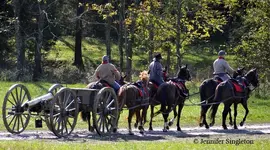 This picture doesn't have anyone riding on the caisson, which would have been done in the Civil War.
This picture doesn't have anyone riding on the caisson, which would have been done in the Civil War.
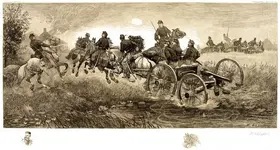 This lithograph shows a couple of guys riding the caisson.
This lithograph shows a couple of guys riding the caisson.
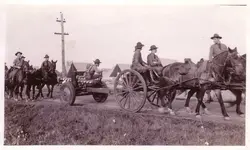 This is a great photo of what looks like WWI era field artillery. Note the guys on the caisson, and the empty
This is a great photo of what looks like WWI era field artillery. Note the guys on the caisson, and the empty
saddle on the closest horse. Which shows me that artillery harness wasn't exactly like other work harness but they had traces and
double trees, the difference would be the saddles.
Another side note, when I was in college, a couple of the guys that I rodeo'd with were from the LA area, and had part time extra
jobs in the movies. One of those guys had been an extra in a movie that the name is long ago forgotten. He was on a gun crew
in the movie, and was riding a wheel horse. The scene required the horses to run, and skid the gun around a corner. He said the
tongue like to tore his leg off. He had to wear a shin guard plus wrap a blanket around his leg.
Every body that has read this, please, this information is from limited memory a long time ago, I've done no
study on the subject. My words are mine and the old timers I learned from, they aren't necessarily the facts,
so don't write your doctorate thesis on what I say. If you disagree with me, I don't care, it's my memories with
all the flaws of old age, and it's darn sure too late to change now.
1- As the drawing posted by BosnMate shows, the wagonhorse harness-with-traces seems to be for use by a single horse. Was it also used for two horses side-by-side?
2- Was the harness-with-traces ever used for a team of more than two horses? If not, that would exclude it from being Artillery horseharness, because you needed no fewer than four horses to pull the enormous weight of a cannon or a caisson (artillery ammo-wagon)."
Yes, each animal in the team has exactly the same harness with the same traces. The wheel animals, "wheelers," have
a tongue between them. If the gun is being pulled by a "four up" the front animals are the leaders, however if they are
using 6 horses or mules, the front team is the leaders, and the middle animals are called the "swing" team, then the
wheelers with the tongue between them. The 4 up leaders have a chain that attaches to the tongue on the caisson at one end and
the lead teams double tree on the other. I found a pretty good picture that will explain better than me trying to type all this
information.
View attachment 859257

This is a 20 mule team, note each animal has the same harness. In this photo, the traces have much
longer chains, I think this must be what Cresol was talking about. There is short leather trace coming from the collar, then
a long chain. Anyhow, the picture shows the leaders and shows how the traces are attached to a double tree. From that
double tree, there is a chain running all the way to the wagon tongue, and each team except the wheelers are attached to,
and have that chain running between them. The leaders don't have the chain between them, the chain ends at their double
tree. This is a side note. Before I was a kid, the farmers in Shandon, Calif. freighted their grain using large wagons and trailers
pulled with 20 mules. By the time I was old enough to realize what was going on, there was only one 20 mule team left, and the
town of Paso Robles had a pioneer day parade every year, and the last 20 mule team pulled wagons in that parade. Grandpa
required that we watch the parade at a sharp corner that those mules and the wagon had to get around. At that corner, the leaders
(several lead teams) would make the turn, and if I remember correctly, three teams in front of the wheel animals jumped the chain
and pulled the wagon straight until it got to the point it could make the turn. Then they jumped back over the chain and made the
corner. Then those mules started dying off, and by the time I was 10 or 11 the team was no longer in the parade. I would
have never known the mules jumped the chain, except Grandpa made sure we saw it. Back to your artillery question. Each animal
on each team wears the same harness with the same type of traces that are attached to double trees. The wheelers have a tongue
between them, the swing has a chain between them, and the leaders have nothing between them. Note in the photo. A stick can be
seen between the two lead mules, attached from the bottom of the one's collar and the head stall of the other. That's called a "spreader"
where I come from, and keeps each animal from having a mind of it's own, keeps them both going the same direction. The 20 mule
team was controlled with a "jerk line." I have no idea how that works, except that each mule had a name, usually preceded with an
adjective not used in gentile society, and he had a pocket of rocks. A stage coach the driver used lines to control each individual animal,
so he has leather straps or lines between all his fingers, and he's using both hands. Just as a side note, reins are not use with harness animals,
at least where I come from on either driving or work teams or even individual driven animals, reins are called "lines." However artillery was
different, in that the horses were ridden instead of driven. Here is a picture of some reenactors pulling a gun with a 6 up.
View attachment 859285
 This picture doesn't have anyone riding on the caisson, which would have been done in the Civil War.
This picture doesn't have anyone riding on the caisson, which would have been done in the Civil War.  This lithograph shows a couple of guys riding the caisson.
This lithograph shows a couple of guys riding the caisson.  This is a great photo of what looks like WWI era field artillery. Note the guys on the caisson, and the empty
This is a great photo of what looks like WWI era field artillery. Note the guys on the caisson, and the empty saddle on the closest horse. Which shows me that artillery harness wasn't exactly like other work harness but they had traces and
double trees, the difference would be the saddles.
Another side note, when I was in college, a couple of the guys that I rodeo'd with were from the LA area, and had part time extra
jobs in the movies. One of those guys had been an extra in a movie that the name is long ago forgotten. He was on a gun crew
in the movie, and was riding a wheel horse. The scene required the horses to run, and skid the gun around a corner. He said the
tongue like to tore his leg off. He had to wear a shin guard plus wrap a blanket around his leg.
Every body that has read this, please, this information is from limited memory a long time ago, I've done no
study on the subject. My words are mine and the old timers I learned from, they aren't necessarily the facts,
so don't write your doctorate thesis on what I say. If you disagree with me, I don't care, it's my memories with
all the flaws of old age, and it's darn sure too late to change now.
Last edited:
Upvote
0
BosnMate
Gold Member
- Joined
- Sep 10, 2010
- Messages
- 6,916
- Reaction score
- 8,441
- Golden Thread
- 0
- Detector(s) used
- Whites MXT, Whites DFX, Whites 6000 Di Pro
- Primary Interest:
- Other
I was just looking at the WWI photo. Note there are no work harness collars on the horses. They are using "breast collar harness,"
which lowers the point of pull to under the riders leg, and makes sense if you think about it a bit. I see the same
thing on the reenactors gun they have the same type of breast collar harness. Look at how low the traces are on those horses. Like
I said, I'm learning, I've never been involved in pulling artillery, my job was to take the marines to the beach.
which lowers the point of pull to under the riders leg, and makes sense if you think about it a bit. I see the same
thing on the reenactors gun they have the same type of breast collar harness. Look at how low the traces are on those horses. Like
I said, I'm learning, I've never been involved in pulling artillery, my job was to take the marines to the beach.
Last edited:
Upvote
0
BosnMate
Gold Member
- Joined
- Sep 10, 2010
- Messages
- 6,916
- Reaction score
- 8,441
- Golden Thread
- 0
- Detector(s) used
- Whites MXT, Whites DFX, Whites 6000 Di Pro
- Primary Interest:
- Other
One more photo.
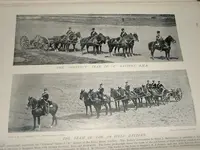 These pictures were supposedly taken in 1936, and these horses have collar harness. The pixelates when I try
These pictures were supposedly taken in 1936, and these horses have collar harness. The pixelates when I try
and enlarge it, so I can't tell if they are using short trace/heel chains. But in a previous post the reenactors have the shorter chains.
It's an interesting subject if a person is into trivia. The harness is surely army surplus, but when the US swivel was first used is any
ones guess right now.
 These pictures were supposedly taken in 1936, and these horses have collar harness. The pixelates when I try
These pictures were supposedly taken in 1936, and these horses have collar harness. The pixelates when I tryand enlarge it, so I can't tell if they are using short trace/heel chains. But in a previous post the reenactors have the shorter chains.
It's an interesting subject if a person is into trivia. The harness is surely army surplus, but when the US swivel was first used is any
ones guess right now.
Upvote
0
TheCannonballGuy
Gold Member
- Joined
- Feb 24, 2006
- Messages
- 6,607
- Reaction score
- 13,455
- Golden Thread
- 0
- Location
- Occupied CSA (Richmond VA)
- Detector(s) used
- White's 6000, Nautilus DMC-1, Minelab
- Primary Interest:
- Relic Hunting
I very much appreciate each of the informational contributions by various posters in this discussion.
Regarding the time-period of the US-marked swivels on the chains:
I've been told by several oldtimer horse-farmers who used those chains (and still have several of them in the barn) that they are 20th-Century Army-surplus chains. I should mention that they are EXTREMELY rarely reported to have been found on a civil war battlefield. Instead, most we see are in rusty but NON-EXCAVATED condition. The combination of reported facts causes me to believe with confidence that the US-marked-swivel chains are strictly from the first three decades of the 1900s.
Regarding the time-period of the US-marked swivels on the chains:
I've been told by several oldtimer horse-farmers who used those chains (and still have several of them in the barn) that they are 20th-Century Army-surplus chains. I should mention that they are EXTREMELY rarely reported to have been found on a civil war battlefield. Instead, most we see are in rusty but NON-EXCAVATED condition. The combination of reported facts causes me to believe with confidence that the US-marked-swivel chains are strictly from the first three decades of the 1900s.
Last edited:
Upvote
0
I very much appreciate each of the informational contributions by various posters in this discussion.
Regarding the time-period of the US-marked swivels on the chains:
I've been told by several oldtimer horse-farmers who used those chains (and still have several of them in the barn) that they are 20th-Century Army-surplus chains. I should mention that they are EXTREMELY rarely reported to have been found on a civil war battlefield. Instead, most we see are in rusty but NON-EXCAVATED condition. The combination of reported facts causes me to believe with confidence that the US-marked-swivel chains are strictly from the first three decades of the 1900s.
In your picture I believe I can see a 193- It could be 2 or 9 or even a 6
Upvote
0
parsonwalker
Bronze Member
- #16
Thread Owner
Thanks everybody. Well, THIS sure opened up a discussion-and-a-half, didn't it? I never thought CW, BTW . . . always assumed WWI. Thanks again.
Upvote
0
TheCannonballGuy
Gold Member
- Joined
- Feb 24, 2006
- Messages
- 6,607
- Reaction score
- 13,455
- Golden Thread
- 0
- Location
- Occupied CSA (Richmond VA)
- Detector(s) used
- White's 6000, Nautilus DMC-1, Minelab
- Primary Interest:
- Relic Hunting
Thank you to each poster who helped decipher the date. 

Upvote
0
SheliaME
Tenderfoot
- Joined
- May 21, 2017
- Messages
- 1
- Reaction score
- 0
- Golden Thread
- 0
- Primary Interest:
- All Treasure Hunting
Hi everyone,
I have recently dug up what my brother says is a trace chain. I found this forum in trying to find info about it. If this is not the proper place to post this please let me know where to post it. I do believe it is a trace chain but I would like to know the age and what the initials on it stands for. The chain is 9' 4" long. Is rusty and I have soaked it in Kerosene which is what it is in, in this photo. The links were rusted and frozen in place but have loosened. The swivel is still tight. I am pretty sure after cleaning it up more since this photo that the initials are B G. Any one have any suggestions on the age and what possibly the initials B G stands for? I hope the photo is attached. Thanks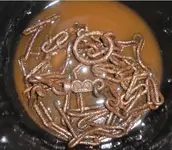
I have recently dug up what my brother says is a trace chain. I found this forum in trying to find info about it. If this is not the proper place to post this please let me know where to post it. I do believe it is a trace chain but I would like to know the age and what the initials on it stands for. The chain is 9' 4" long. Is rusty and I have soaked it in Kerosene which is what it is in, in this photo. The links were rusted and frozen in place but have loosened. The swivel is still tight. I am pretty sure after cleaning it up more since this photo that the initials are B G. Any one have any suggestions on the age and what possibly the initials B G stands for? I hope the photo is attached. Thanks

Upvote
0
Engineer in MD
Full Member
- Joined
- Jan 6, 2011
- Messages
- 102
- Reaction score
- 124
- Golden Thread
- 0
- Location
- Berlin/Ocean City, MD
- Detector(s) used
- Whites V3i, Whites Eagle II SL, Pro Pointer
- Primary Interest:
- All Treasure Hunting
TheCannonballGuy,
That image is from this website US Army Horse Drawn Equipment
Would they not have a higher resolution image or a better copy of the original?
I have done some image enhancement, but enhancing text is one of the most difficult to near impossible with only a single low resolution image to work from.
That image is from this website US Army Horse Drawn Equipment
Would they not have a higher resolution image or a better copy of the original?
I have done some image enhancement, but enhancing text is one of the most difficult to near impossible with only a single low resolution image to work from.
Rather than a "rebuttal," please think of this as a contribution of helpful information.
About a year ago, while I was researching the time-period of these US-marked SO-CALLED "artillery trace-chains." I came across the following educational diagram. It is an official US Army Commisary Department document, and is marked as such at the lower right in the diagram. It is titled "Harness, Ambulance Or Escort Wagon, Lead And Wheel, Double Sets -- Trace, Hame: Straps, Hame." Unfortunately, it is a low-resolution scan of the original document... which makes some of the writing difficult to read, and in particular, the date, which seems to be Nov. 5, 19--. But because the US Army quit using horse-drawn wagons by sometime in the 1930s, we can be sure the diagram's date of 19-- is sometime between 1900 and 1939... and most likely in the earlier part of that range.
I hope somebody in this forum is good at digital image enhancement, and can clear up this low-rez scan's writing for us.
In the meantime, I'll do the best I can at interpreting important parts of the writing. Note that at the diagram's bottom left, we see a drawing marked "TRACE [something]" and below it, "body, [something,] trace-guard and [something:] black harness leather, medium, 12/64 thick [plus or minus 1/64.)"
Also, note that Creskol's mention of concern about "flesh-wounds" is correct, most of the trace's length is leather, in order to protect the horse from flesh-wounds which a chain would inflict. The chain part of the trace is only at its end BEYOND the horse's body... as shown in the drawing posted by BosnMate. (I should mention that the diagram has a black space (representing a gap) in the strap and in the chain, because they are too lengthy to draw their full length in the diagram.)
Lastly, note that the trace end's chain and HOOK is the same shape as the one found by Parsonwalker... except that the swivel on the diagram's chain is unmarked.
I should mention that in addition to BosnMate's testimony in this discussion that these "US" chains are from the early-1900s, I've talked with elderly farmers who've told me the same thing BosnMate said. These US wagon-horseharness traces were sold as Army-Surplus equipment after World War 2 through the 1960s. They date from no earlier than the first decades of the 20th-Century. For example, a close personal friend of mine lives on a horse-boarding farm, and he found TEN sets of these US-marked chains in the old barn... so how likely is it that they are from the civil war?
In closing, I've got two questions for Creskol:
1- As the drawing posted by BosnMate shows, the wagonhorse harness-with-traces seems to be for use by a single horse. Was it also used for two horses side-by-side?
2- Was the harness-with-traces ever used for a team of more than two horses? If not, that would exclude it from being Artillery horseharness, because you needed no fewer than four horses to pull the enormous weight of a cannon or a caisson (artillery ammo-wagon).
One other request (already mentioned above)... I hope somebody in this forum is good at digital image enhancement, and can clear up this low-rez scan's writing for us.
Upvote
0
Similar threads
- Replies
- 5
- Views
- 541
- Replies
- 3
- Views
- 659
- Question
🔎 UNIDENTIFIED
I need help identifying a druggist bottle from DC
- Replies
- 1
- Views
- 361
Users who are viewing this thread
Total: 1 (members: 0, guests: 1)

